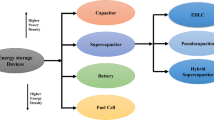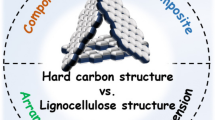Abstract
In this study, the regenerated porous cellulose films were properly prepared by dissolving different masses of cellulose (4%, 6%, 8%) in LiCl/DMAc solvent though a simple phase inversion process and as separator (CLD-4, CLD-6, CLD-8) for the assembled supercapacitors (ABSC-4, ABSC-6, ABSC-8). The investigation on the different masses of cellulose indicated that CLD-8 film showed a stronger hydrogen bond interaction, higher thermal stability and better tensile strength. In addition, CLD-8 has good lyophilicity (101.1°), high porosity (58.43%), and electrolyte absorption (329.30%). Furthermore, different cellulose films as separator were used for assembling supercapacitor. Compared with ABSC-4 and ABSC-6, ABSC-8 showed a lower equivalent series resistance of 0.37Ω, a higher charge-discharge efficiency of 98.87% at 1 A/g, and areal capacitance of 1.16 F/cm2 at 5 mV/s. ABSC-8 also showed a superior capacity retention of 92.09% over 4000 cycles at 1 A/g. So, CLD-8 film has a potential to be used as separator for supercapacitor. Furthermore, the comparative analysis of supercapacitors assembled by CLD-8 separator and two commercial separators were conducted. The results show that ABSC-8 showed a higher value of 25.94 Wh/kg at 0.5 A/g with a powder density of 0.36 kW/kg, a lower voltage drops below 0.02 V at 1.0, and 3.0 A/g, a higher specific capacitance of 123 F/g at 0.5 A/g. Moreover, ABSC-8 maintained their quasi-rectangular and symmetrical triangular profiles of the CV and GCD curves in 0–1 and 0–1.5 V, respectively, suggesting the applicability of a wide working potential window. These results provide insights into the full use of natural and biodegradable cellulose film prepared by a simple phase inversion as separators for supercapacitors.







Similar content being viewed by others
References
P. Tang, L. Han, L. Zhang, Facile synthesis of graphite/PEDOT/MnO2 composites on commercial supercapacitor separator membranes as flexible and high-performance supercapator electrodes. ACS Appl. Mater. Interfaces 6, 10506–10515 (2014)
C. Wang, X. Wang, H. Lu, H. Li, X.S. Zhao, Cellulose-derived hierarchical porous carbon for high-performance flexible supercapacitors. Carbon 140, 139–147 (2018)
Z. Peng, Y. Zou, S. Xu, W. Zhong, W. Yang, High-performance biomass-based flexible solid-state supercapacitor constructed of pressure-sensitive lignin-based cellulose hydrogels. ACS Appl. Mater. Interfaces 10, 22190–22200 (2018)
H. Zhang, X. Wang, Y. Liang, Preparation and characterization of a lithium-ion battery separator from cellulose nanofibers. Heliyon 1, e00032 (2015)
K. Sun, D.A. Juarez, H. Huang, E. Jung, S.J. Dillon, Aqueous lithium-ion batteries on paper substrates. J. Power Sources 248, 582–587 (2014)
C. Wan, Y. Jiao, J.A. Li, Cellulose fibers-supported hierarchical forest-like cuprous oxidecopper array architecture as a flexible and free-standing electrode for symmetric supercapacitors. J. Mater. Chem. A 5, 17267–17278 (2017)
Y. Ma, X.L. Xie, R.H. Lv, B. Na, J.B. OuYang, H.S. Liu, Nanostructured polyaniline–cellulose papers for solid-state flexible aqueous Zn-ion Battery. ACS. Sustain. Chem. Eng. 6, 8697–8703 (2018)
B. Chang, J. Chen, M.G. Z, X.J. Z, W.W. Prof, B.D. Prof, S.H. Prof, Y.S. He, Three-dimensional graphene-based N-doped carbon composites as high-performance anode materials for sodium-ion batteries. Chem-Asian. J. 13, 3859–3864 (2018)
J. Fei, Y.L. Cui, J.Y. Li, Z.W. Xu, J. Yang, R.Y. Wang, Y.Y. Cheng, J.F. Hang, A flexible Sb2-O3/carbon cloth composite as free-standing high performance anode for sodium-ion batteri-es. Chem. Commun. 53, 13165–13167 (2017)
T. Zhang, L. Yang, X. Yan, X. Ding, Recent advances of cellulose-based materials and their promising application in sodium-ion batteries and capacitors. Small 14, 1802444 (2018)
L. Li, F.X. Lu, C. Wang, F.L. Zhang, W.H. Liang, S.G. Kuga, Z.C. Dong, Y. Zhao, Y. Huang, M. Wu, Flexible double-cross-linked cellulose-based hydrogel and aerogel membrane for supercapacitor separator. J. Mater. Chem. A 6, 24468–24478 (2018)
H. Zhu, W. Luo, P.N. Ciesielski, Z.Q. Fang, J.Y. Zhu, G. Henriksson, M.E. Himmel, L.B. Hu, Wood-derived materials for green electronics, biological devices, and energy applications. Chem. Rev. 116, 9305–9374 (2016)
N. Pavlin, S.L. Hribernik, G. Kapun, S.D. Talian, C.N. Dedryvere, R. Dominko, The role of cellulose based separator in lithium sulfur batteries. J. Electrochem. Soc. 166, 5237–5243 (2018)
S. Taira, M. Kurihara, K. Koda, K. Sugimura, Y.Y. Nishio, Y. Uraki, Tempo-oxidized cellulose nanofiber-reinforced lignin based polyester films as a separator for electridouble-layer capacitor. Cellulose 26, 569–580 (2018)
X. Sun, C.T. Mei, A.D. French, S.Y. Lee, Y. Wang, Q.L. Wu, Surface wetting behavior of nanocellulose-based composite films. Cellulose 25, 5071–5087 (2018)
Z. Wang, Y.S. Xie, C.H. Xu, S.Y. Shi, L. Wang, G.H. Zhang, X.Q. Wang, L.Y. Zhu, D. Xu, Zirconia fiber membranes based on PVDF as high-safety separators for lithium-ion batteries using a papermaking method. J. Solid State Electron. 23, 269–276 (2018)
Q. Xu, Q.S. Kong, Z.H. Liu, X.J. Wang, R.Z. Liu, L.P. Yue, Y.L. Duan, G.L. Cui, Cellulose/polysulfonamide composite membrane as a high performance lithium-ion battery sepa-rator. ACS. Sustain. Chem. Eng. 2, 194–199 (2013)
T. FO’Connor, A.V. Zaretski, S. Savagatrup, A.D. Printz, C.D. Wilkes, M. Diaz, E.J. Sawyer, D.J. Lipomiet, Wearable organic solar cells with high cyclic bending stability: materials selection criteria. Sol. Energy Mater. Sol. Cells 144, 438–444 (2016)
F. Du, R.C. Scogna, W. Zhou, S. Brand, J.E. Fischer, K.I. Wineyet, Nanotube network in polymer nanocomposites:rheology and electrical conductivity. Macromolecules 37, 9048–9055 (2004)
H. Wang, X.Y. Shen, G.X. Tian, X.S.,W. Huang, Y. Guang, W.L. Sun, C. Peng, S.S. Liu, Y. Huang, X.Y. Chen, F. Zhang, Y.J. Chen, W.L. Ding, Z.B. Lu, Ampkα2 deficiency exacerbates long-term PM2.5 exposure-induced lung injury and cardiac dysfunction. Free Radical Bio. Med. 121, 202–214 (2018)
M. Yu, J. Li, L. Wang, KOH-activated carbon aerogels derived from sodium carboxymethcellulose for high-performance supercapacitors and dye adsorption. Chem. Eng. J. 31, 300–306 (2017)
X. Yang, L. Kong, J. Ma, X. Liu, Facile construction of hierarchically porous carbon nanofiber aerogel for high-performance supercapacitor. J. Appl. Electrochem. 49, 241–250 (2018)
C. Wan, J. Li, Cellulose aerogels decorated with multi-walled carbon nanotubes: preparation, characterization, and application for electromagnetic interference shielding. Front. Chem. Sci. Eng. 2, 341–346 (2015)
Y. Yang, Z. Tong, T. Ngai, C. Wang, Nitrogen-rich and fire-resistant carbon aerogels for the removal of oil contaminants from water. ACS Appl. Mater. Interfaces 6, 6351–6360 (2014)
Z. Yang, J. Ren, Z.T. Zhang, X.L. Chen, G.Z. Guan, L.B. Qiu, Y. Zhang, H.S. Peng, Recent advancement of nanostructured carbon for energy applications. Chem. Rev. 115, 5159–5223 (2015)
Q. Yao, H. Wang, C. Wang, C. Jin, Q. Sun, One step construction of nitrogen–carbon derived from bradyrhizobium japonicum for supercapacitor applications with a soybean leaf as a separator. ACS. Sustain. Chem. Eng. 6, 4695–4704 (2018)
Z. Du, Y.Z. Su, Y.Y. Qu, L.Z. Zhao, X.B. Jia, Y. Mo, F. Yu, J. Du, Y. Chen, A mechanically robust, biodegradable and high performance cellulose gel membrane as gel polymer electrolyte of lithium-ion battery. Electrochem. Acta 299, 19–26 (2019)
L. Yue, Y.J. Xie, Y.D. Zheng, W. He, S.L. Guo, Y. Sun, T. Zhang, S. Liu, Sulfonated bacterial cellulose/polyaniline composite membrane for use as gel polymer electrolyte. Compos. Sci. Technol. 145, 122–131 (2017)
W. Chen, L.P. Zhang, C.T. Liu, X.M. Feng, J.M. Zhang, L.Q. Guan, L.W. Mi, S.Z. Cui, Electrospun flexible cellulose acetate-based separators for sodium-ion batteries with ultralong cycle stability and excellent wettability: the role of interface chemical groups. ACS Appl. Mater. Interfaces 10, 23883–23890 (2018)
S. Wang, D. Zhang, Z. Shao, S. Liu, Cellulosic materials-enhanced sandwich structure-like separator via electrospinning towards safer lithium-ion battery. Carbohydr. Polym. 214, 328–336 (2019)
A. Fujishima, K. Honda, Electrochemical photolysis of water at a semiconductor electrode. Nature 238, 37–38 (1972)
A. Razaq, L. Nyholm, M. Sjödin, M. Strømme, A. Mihranyan, Paper-based energy-storage devices comprising carbon fiber-reinforced polypyrrole-cladophora nanocellulose composite electrodes. Adv. Energy Mater. 2, 445–454 (2012)
Y. Li., G.Y. Ren, Z.Q. Zhang, C. Teng, Y.Z. Wu, X.Y. Lu, Y. Zhu, L. Jiang, A strong and highly flexible aramid nanofibers/PEDOT:PSS film for all-solid-state supercapacitors with superior cycling stability. J. Mater. Chem. A 4, 17324–17332 (2016)
J. Luo, F.R. Fan, T. Jiang, Z.W. Wang, W. Tang, C.P. Zhang, M.M. Liu, G.Z. Cao, Z.L. Wang, Integration of micro-supercapacitors with triboelectric nanogenerators for a flexible self-charging power unit. Nano Res. 8, 3934–3943 (2015)
R. Pan, O. Cheung, Z.H. Wang, P. Tammela, J.X. Huo, J. Lindh, K. Edströma, M. Strømme, L. Nyholma, Mesoporous cladophora cellulose separators for lithium-ion batteries. J. Power Sources 321, 185–192 (2016)
H. Wang, H. Gao, A sandwich-like composite nonwoven separator for lion batteries electrochim. Acta 215, 525–534 (2016)
A. Sharma, A.K. Rath, Improved performance and reproducibility of perovskite solar cells by jointly tuning the hole transport layer and the perovskite layer deposition. J. Mater. Sci. 29, 12652–12661 (2018)
X. Zhong, J. Tang, L.J. Cao, W.G. Kong, Z. Sun, H. Cheng, Z.G. Lua, H. Pan, B.M. Xu, Cross-linking of polymer and ionic liquid as high-performance gel electrolyte for flexible solid-state supercapacitors. Electrochim. Acta 244, 112–118 (2017)
C.M. Costa, H.M. Rodrigues, A. Gören, P.V. Machado, P.M. Silva, P.S. Lanceros-Ménde, Preparation of poly(vinylidene fluoride) lithium-ion battery separators and their compatibilization with lonic liquid-A green solvent approach. ChemistrySelect 2, 5394–5402 (2017)
H. Xu, X.L. Hu, Y.M. Sun, H.L. Yang, X.X. Liu, Y.H. Huang, Flexible fiber-shaped sup-ercapacitors based on hierarchically nanostructuredcomposite electrodes. Nano Res. 8, 1148–1158 (2014)
L. Cao, M.Y. Yang, D. Wu, F.C. Lyu, Z.F. Sun, X.W. Zhong, H. Pan, H.T. Liu, Z.G. Lu, Biopolymer-chitosan based supramolecular hydrogels as solid state electrolytes for electroche-mical energy storage. Chem. Commun. 53, 1615–1618 (2017)
Acknowledgements
This work was supported by the Natural Science Foundation of Guangxi (2018GXNSFBA138025).
Author information
Authors and Affiliations
Corresponding author
Additional information
Publisher's Note
Springer Nature remains neutral with regard to jurisdictional claims in published maps and institutional affiliations.
Rights and permissions
About this article
Cite this article
Teng, G., Lin, S., Xu, D. et al. Renewable cellulose separator with good thermal stability prepared via phase inversion for high-performance supercapacitors. J Mater Sci: Mater Electron 31, 7916–7926 (2020). https://doi.org/10.1007/s10854-020-03330-w
Received:
Accepted:
Published:
Issue Date:
DOI: https://doi.org/10.1007/s10854-020-03330-w




